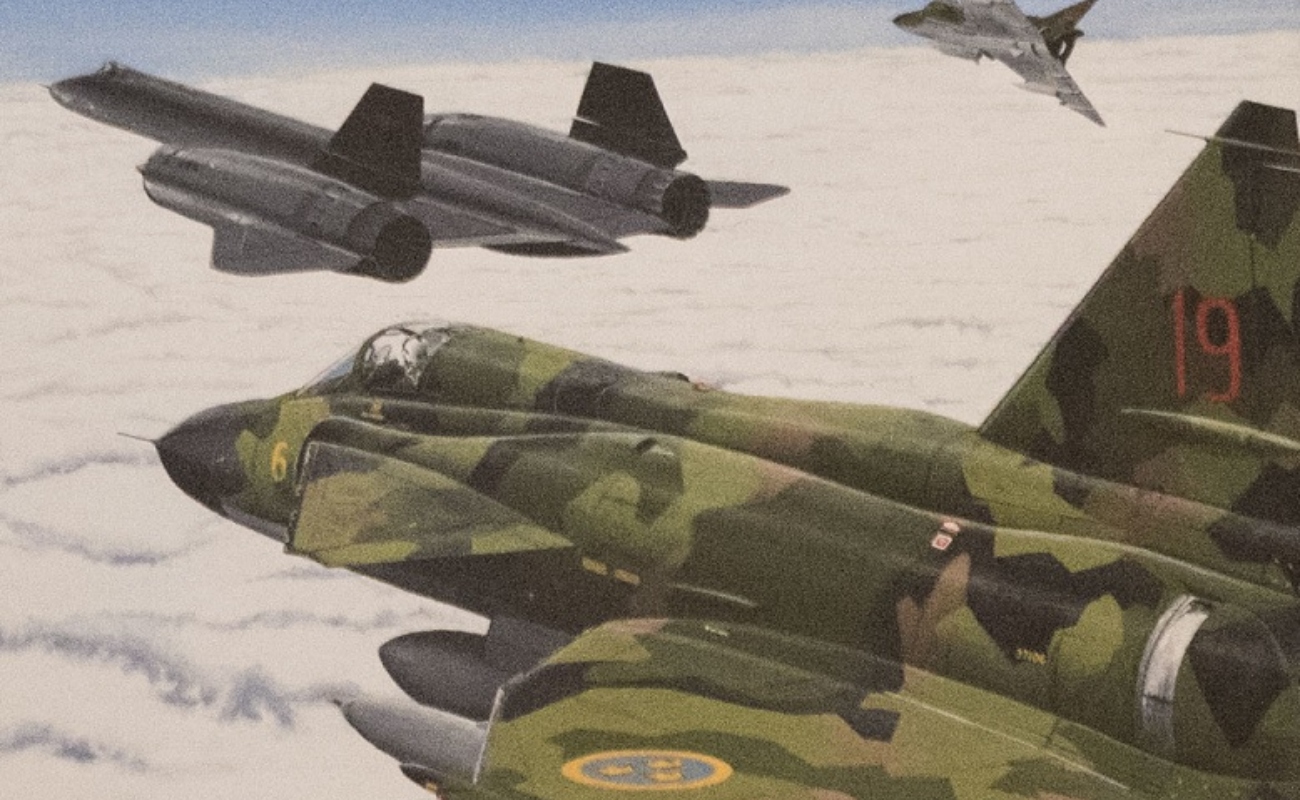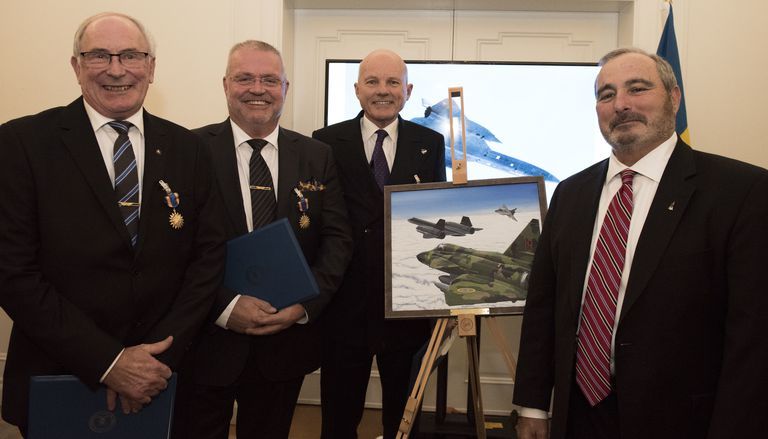A video on platform X (formerly Twitter) showed two Swedish SAAB JA-37 Viggen fighters armed with air-to-air missiles flying beside an American SR-17 Blackbird. While both aircraft are retired now, and the photograph is from a previous time in history, the incident nevertheless warrants retelling, given that the continent is again experiencing tensions with Russia.
Damaged SR-71 being escorted by 2 JA 37 Viggens over the Baltic Sea near Soviet territory pic.twitter.com/4Eo1cxscjD
— Historic Vids (@historyinmemes) March 17, 2024
The video is a computer-generated rendition of an event from June 29, 1987.
A US Air Force (USAF) SR-71 Blackbird flying in neutral, international Airspace over the Baltic Sea experienced an engine failure. Two pairs (four aircraft) of Swedish Air Force Viggens intercepted and escorted it out of the Airspace.
Casually known as the “Baltic Express,” the routine SR-71 flights photographed the Soviet Navy’s Northern Fleet in the Kola Peninsula while flying at extremely high speeds from high altitudes.
Times Change, History Repeats Itself
This was four years before the Union of Soviet Socialist Republics (USSR) dissolved. The Soviet intervention in Afghanistan was still underway, the Berlin Wall was still up, and tense undercurrents remained between Washington and Moscow. However, around this time, talks of a rapprochement between the countries were rife, and there was a mutual desire to bury tensions.
These intercepts were undertaken because neutral Sweden could not be seen allowing US spy planes into its Airspace. Thus the intent behind racing to catch the Blackbird with its fighters was more diplomatic signaling than military.
How the JA37 Viggen intercepted the Blackbird will be explained subsequently.

The event was classified until 2017, and on November 28, 2018, the USAF held a ceremony in Stockholm to honor the four Swedish pilots. Then, the Mobilization Assistant to the commander of the US Air Forces in Europe, Africa, Maj Gen John Williams, awarded the medals to the now retired Swedish pilots: Col. Lars-Eric Blad, Maj. Roger Moller, Maj. Krister Sjoberg and Lt. Bo Ignell.
Moscow is fighting in Ukraine, and Sweden is no longer neutral, having joined the North Atlantic Treaty Organization (NATO). Ironically, while tensions and fears of a hot nuclear war between the West and the former Soviet Union were higher, the conflict never actually happened, and the Communist superpower peacefully dissolved.
Today, while the chances of Europe and Russia clashing are relatively lesser, the nuclear overhang is also not acute, except for the occasional brinkmanship; Russia is fighting in Ukraine in the largest war in the continent since World War 2.
SR-71 Lost An Engine
Flown by Lieutenant Colonels Duane Nolls and Tom Veltri, one of the SR-71’s Pratt and Whitney turbofans, J58-1, lost power, forcing it to descend 25,000 feet over Swedish air space. Here, it was intercepted by two SAAB J37 Viggen fighter jets from the Swedish Air Force.
Neutral Sweden, which was neither in the US nor the Soviet bloc, was intended for a purpose beyond just escorting a wayward aircraft. This was to prevent any Soviet fighters from harassing the SR-71, as Russian and NATO aircraft do to each other today—engaging in maneuvers that are just short of kinetic or hostile. Moreover, with one engine down, neither can the SR-71 go full throttle and speed away.

The Russian fighters often scrambled MiG-25PD ‘Foxbat’ to intercept the Blackbird. In this case, the Russian MiG-25s took off from East Germany (or the German Democratic Republic). They often took off while attempting to intercept the Baltic Express SR-71 flights over the Baltic Sea. While unsuccessful, the SR-71, minus one engine, was vulnerable.
But even more ironically, the only jet to achieve a ‘radar lock’ on the Blackbird was also the SAAB J37 Viggen – thanks to an unconventional tactic developed by the Swedish Air Force. (This will be explained subsequently).
US Air Force Thanks Swedish Pilots
Thirty-one years later, the USAF expressed its gratitude towards the Swedish pilots for protecting their aircraft from a shootdown. “I can’t say enough about these gentlemen,” said Veltri, one of the SR-71 pilots during the ceremony. “I am so amazingly grateful for what they did, but also for the opportunity to recognize them in the fashion we are doing. What these guys did is truly monumental.”
Noll, the other SR-71 pilot, was unable to attend the ceremony but recorded a message for those in attendance. “Your obvious skills and judgment were definitely demonstrated on that fateful day many years ago. I want to thank you for your actions,” Noll said.
“We will never know what would or could have happened, but because of you, there was no international incident. The US Air Force did not lose an irreplaceable aircraft, and two crew members’ lives were saved. Lt. Col. Veltri and I can’t thank you sufficiently for what you prevented. Thank you for being highly skilled and dedicated patriotic fellow aviators,” he said.
Meanwhile, Williams said that “that day in 1987 showed us that we can always count on our Swedish partners in times of great peril.” “Even when there was both political risk and great physical risk in the form of actual danger, there was no hesitation on your part to preserve the pilots on that day.”
How the JA-37 ‘Radar Locked’ the SR-71
During their Baltic Express route, the SR-71s consistently entered a specific waypoint, “Codan,” 80 km south of Copenhagen, to trigger the Swedish air defense radar. The Viggens were subsequently scrambled. Seeing how it was a near-impossible task to intercept the Blackbird from behind, Per-Olof Eldh, a Viggen pilot, devised an unconventional and bold tactic of approaching the Blackbird head-on!
It required the JA-37s to perform a steep climb to reach an altitude just below the SR-71, followed by an acceleration to Mach 2 speeds, and then climb again to fly directly towards the SR-71 from the front.
Usually, an intercept from behind allows the interceptor’s missiles a better chance to lock on to the target. But Viggen’s PS-46 air-to-air pulse Doppler radar, combined with the Skyflash missile, enhanced its capability.
Moreover, the Viggen had a highly sophisticated data link at the time, in addition to other advanced electronics and avionics—something the MiG-25 lacked. The most challenging phase of this plan was during the steep climb, as the pilots had to simultaneously watch the Volvo Flygmotor RM8B turbofan jet engine’s temperature limits and scan their radar screens.

During this phase, the pilot would tilt his radar scan angle down, and the radar then had a few seconds to locate and lock on to the target before the two aircraft passed one another with a combined speed of Mach 5. The plan was successfully realized for the first time in January 1986, when the Swedish fighter pilot, Per-Olof Eldh, received an alert of an SR-71 approaching Swedish Airspace.
“The data link from the fighter controller was on, and I lined up for a head-on attack with a target angle of 180 degrees. From my altitude of 8,000 meters, I accelerated to Mach 1.35 then pulled up, very gently, continuing to accelerate to between Mach 1.7 and Mach 2.0, topping out at between 18,500 meters and 20,000 meters,” he was quoted on Aviation Geek Club.
All the target data was on his map’s display, including radar detection of the target at maximum range, which then locked on immediately afterward. “I simulated missile launches – the closing velocity was very high, between Mach 4.5 and 5.0; the SR-71 was flying at Mach 2.98. I had visual contact,” Eldh was quoted on Aviation Geek Club.
Eldh added that he had “five hot intercepts against the SR-71” to his credit. “I was visual three times; on several occasions, the SR-71 was contrailing, which was very useful because you could do a visual check to ensure you ended up in the right spot!”
- The author can be reached at satamp@gmail.com
- Follow EurAsian Times on Google News




